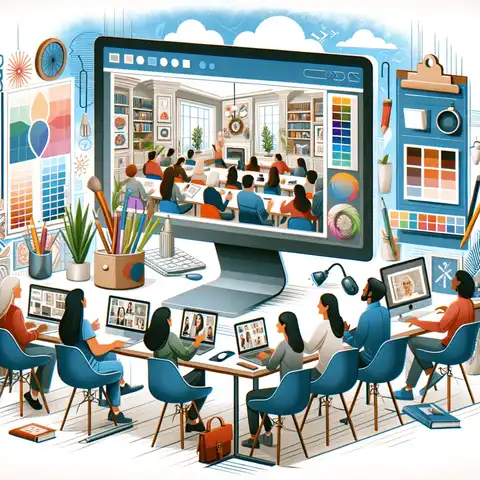How to Become an Interior Designer Online? Have you ever dreamed of making rooms look beautiful? Interior designers do just that, but online! This article will show you how to start this exciting career from your computer.
What’s Interior Design?
Think of interior design like art, but for rooms and buildings. When you’re an interior designer, you get to pick colors, furniture, and decorations to make places look nice and feel good. It’s like helping a room tell its story using colors and shapes!
What Do They Do?
Interior designers are like room detectives. They figure out the best way to arrange a room. They choose things like sofas, tables, and lamps. They even decide where windows and doors should go. And the best part? They work with people, turning their ideas into real, beautiful spaces. Imagine talking to someone and then making their dream room come true!
Skills You Need
To be a good interior designer, you need a few special skills:
- Design Skills: You should have a good eye for what looks nice.
- Know the Rules: Buildings have rules, like how big a room should be or where a window can go.
- Talking and Listening: You’ll work with lots of different people. Being able to talk clearly and listen well is super important.
Being an interior designer is fun and creative. You get to make spaces beautiful and make people happy with your designs.
Educational Pathways
Learning First: Why Education Matters
Evolving as an interior designer is exciting, but first, you are required to learn the ropes. Why? Designing a space isn’t just about making it look good; it’s about making it safe, comfortable, and practical too. Plus, you need to understand things like color theory, space planning, and materials.
These programs teach you the basics of design and more. You’ll learn how to draw your ideas, use design software, and understand building codes. Think of it like your toolbox – the more tools you have, the better you can build your designs.
Online Schools: Where to Study

Now, where can you learn all this cool stuff? Online, of course! Many schools offer interior design courses on the internet. Here are some things to look for in a good online design school:
- Accreditation: Make sure the school is recognized. This means it meets certain standards.
- Course Content: Check if they cover the basics like design principles, software training, and project management.
- Flexibility: Online courses are great because you can learn at your own pace. But check if they fit your schedule.
- Support: Good schools offer help when you need it, like tutoring or career advice.
- Cost: Find a program that fits your budget. Some might offer financial aid too.
Rules for Being a Designer: Certification and Licensing
In the world of interior design, rules can be different depending on where you live. In some places, you can’t just call yourself an interior designer without a special certificate or license. Why? Because these rules help make sure all designers know what they’re doing, especially when it comes to safety and building codes.
Getting certified usually means you have to pass an exam. The National Council for Interior Design Qualification (NCIDQ) exam is one big one in the United States. To sit for this exam, you often need a combination of education and work experience.
So, if you plan to work in a place that requires certification, choose an online school that prepares you for these requirements.
Essential Tools and Software
In the world of interior design, being tech-savvy is a must. Here’s why: almost all design work today is done digitally. So, what are some of these magic tools?
- AutoCAD: This is a big one. It’s used for drawing floor plans and making design drafts. With AutoCAD, you can create detailed and accurate designs. It’s like the pencil and ruler of the digital world.
- SketchUp: This is for 3D modeling. Imagine taking your flat design and making it pop out like a real room. That’s what SketchUp does.
- Adobe Suite: Includes Photoshop and Illustrator.
- Revit: Another cool program for 3D modeling.
Learning these programs might sound tough, but don’t worry. Many online courses and tutorials can help you master them. And remember, practice makes perfect!
Internet Resources: A World of Knowledge Online

The internet is like a giant library for interior designers. Here are some you’ll find super helpful:
- Online Tutorials and Courses: Websites like Udemy, Coursera, and Lynda offer courses on specific design software and general design principles. They’re great for both beginners and pros.
- Design Blogs and Websites: These are treasure troves of inspiration and tips. Sites like Apartment Therapy or Dezeen showcase trends, projects, and advice from experts.
- YouTube Channels: Many professional designers have channels where they share their process and tips.
- Online Forums and Communities: Places like Reddit’s /r/InteriorDesign or design groups on Facebook are great for asking questions, sharing your work, and meeting other designers.
- Design Podcasts and Webinars: Listen to experts talk about their experiences and stay updated on the latest in design.
Gaining Practical Experience
Learning by Doing: The Value of Internships
You know how they say you learn best by doing? That’s especially true in interior design. Here’s why internships are super important:
- Real-World Experience: Internships let you work on actual projects. It’s like a sneak peek into your future job!
- Skill Building: You’ll learn things that aren’t always taught in classes, like dealing with clients and managing deadlines.
- Networking: You meet professionals who can give advice and might help you find a job later.
And guess what? Many internships can now be done online! You could be designing for a client in another city from your home. Look for online internships on job websites, company websites, or even LinkedIn.
Show Your Work: Creating a Portfolio
Think of a portfolio as your design diary. Here’s how to make a great one:
- Quality Over Quantity: Pick your best projects, not all of them.
- Variety: Show different types of designs – homes, offices, different styles.
- Tell a Story: For each project, explain your design process. What was the challenge? How did you solve it?
- Use Good Images: Make sure your pictures are clear and professional.
- Keep It Updated: As you get better, replace older work with new, better designs.
An online portfolio is great because you can share it easily. Websites like Behance or your own personal website are good places to showcase your work.
Meeting People Online: Networking in the Digital Age
Even in the online world, who you know matters. Networking can open doors for you. Here’s how to do it:
- Social Media: Platforms like Instagram and Pinterest are perfect for sharing your designs. LinkedIn is great for professional connections.
- Join Online Communities: Websites like Houzz, or groups on Facebook and Reddit, let you join conversations and meet other designers.
- Attend Webinars and Online Events: These events are not just for learning; they’re for meeting people too.
- Follow and Interact: Follow designers you admire and interact with their content.
Starting Your Career
Work Choices: Freelance or Company Employment
As you step into the interior design world, one big decision is whether to go solo or join a team. Here’s what to consider:
- Freelance: This means working for yourself. You find your own clients, manage your schedule, and handle all parts of your business.
- Working for a Company: Joining a design firm or a related company means you’ll be part of a team. You might have more consistent work and support, but less control over which projects you work on.
Both paths have their perks. Think about what fits your lifestyle and work preferences best.
Being Seen Online: Building Your Digital Presence
In today’s world, a strong online presence is key to getting noticed. Here’s how to shine online:
- Create a Professional Website: This is your digital home.
- Utilize Social Media: Platforms like Instagram and Pinterest are perfect for visual work like design. Post your projects, share design tips, and engage with your audience.
- Join Online Marketplaces: Websites like Houzz or Upwork can connect you with potential clients.
- SEO: Learn about Search Engine Optimization to make your website more visible in search results.
Think of your online presence as your 24/7 advertisement. The better it is, the more clients you can attract.
Keep Learning: Staying Updated in a Dynamic Field
Interior design is always evolving. New trends, materials, and technologies appear all the time. Staying updated is key to keeping your designs fresh and exciting. Here’s how:
- Follow Design Blogs and Magazines: They’re a source for the latest trends and ideas.
- Online Courses and Workshops: Keep sharpening your skills with ongoing education.
- Networking Events and Webinars: These can be great places to learn about new developments and hear from industry leaders.
- Experiment: Try out new styles and techniques in your projects.
Success Stories
Advice from Pros: Learning from Those Who Made It
There’s nothing quite like hearing from people who’ve already walked the path you’re on. Here’s why success stories are a goldmine:
- Real Experiences: These stories give you a peek into the real world of online interior design. You learn about the highs and the challenges.
- Practical Tips: Pros often share practical advice – how they found their first client, how they manage their day, or how they stay creative.
- Inspiration: Knowing that someone else has succeeded can give you a big motivational boost. If they did it, why not you?
Look for these stories on design blogs, podcasts, or even YouTube channels. Some designers also share their journeys on social media or in online design communities.
Challenges and Solutions
Problems You Might Face: The Realities of Online Interior Design
Starting out, especially online, isn’t always easy. Here are two common challenges:
- Finding Clients: When you’re new, it can be tough to get that first client. Without a track record, people might hesitate to hire you.
- Project Management: Keeping a project on track, especially when communicating mostly online, requires good organization and communication skills.
How to Solve Them: Strategies for Success
Don’t worry, every problem has a solution. Here’s how you can tackle these challenges:
- Building a Client Base: Start with your network. Let friends and family know about your services. Online marketplaces for freelancers can also be a good starting point.
- Effective Project Management: Use online tools like Trello or Asana to keep your projects organized. Make sure to communicate clearly and regularly with your clients. Set clear timelines and expectations from the start.
Conclusion
We’ve had a fun trip learning about becoming an online interior designer! We looked at how to learn design, the cool tools you’ll use, how to start working, and how to solve tricky problems.
If you really like designing, your dream job isn’t far away. Just start with the easy stuff, get better with tools like AutoCAD, make a cool collection of your designs, and meet other designers online.
The most important thing is to trust in your own ideas and be creative. The internet has so many chances for you to be great. Work hard and stay focused, and you can be an awesome interior designer online!
Appendix
Extra Help: Resources for Aspiring Interior Designers
To give you a head start, here’s a list of some resources that can be incredibly helpful:
- Online Courses:
- Coursera: Offers courses in interior design basics, software skills, and more.
- Udemy: Find specific courses on tools like AutoCAD and SketchUp.
- Tools for Design and Organization:
- SketchUp, AutoCAD, and Adobe Suite for design work.
- Trello or Asana for project management.
- Communities and Networking:
- LinkedIn and Houzz for professional networking.
- Reddit’s /r/InteriorDesign and Facebook groups for community support.
- Design Blogs and Websites:
- Dezeen and Apartment Therapy for inspiration and industry news.
- Behance for portfolio ideas and inspiration.
FAQs
- Q: How long does it take to become an interior designer? A: It varies. A degree can take 2-4 years, but learning is ongoing with new trends and tools.
- Q: Can I start working without a degree? A: Yes, but a degree or certification can provide valuable knowledge and credibility.
- Q: How much can I earn as an online interior designer? A: Income varies widely depending on experience, location, and whether you work freelance or with a company.
- Q: Do I need to be good at drawing to be an interior designer? A: Traditional drawing skills are helpful, but not a must. You’ll mostly use digital tools for designing.
The world needs your creativity and vision – so go ahead, and start designing your future today!



